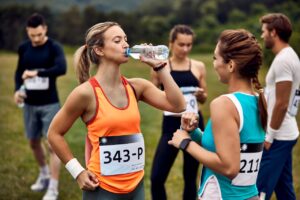Running a marathon in itself is a major challenge for the mind and body. Running a marathon in a costume is doubly difficult. Therefore, it is important to make sure that your body is fully prepared for the increased stress and gets the necessary micronutrients and water. Here are some tips to help you prepare for a marathon in a costume.
Nutrition Tips
Proper nutrition is vital for sustaining energy levels throughout the marathon. Start by focusing on your diet in the weeks leading up to the race. Consuming a balanced diet rich in carbohydrates, proteins, and healthy fats will help build up your energy reserves.
On race day, eat a carbohydrate-rich meal about three to four hours before the marathon. This could include oatmeal, bananas, or a bagel with peanut butter. Avoid heavy, greasy foods that can cause digestive issues.
During the race, consume easily digestible energy gels or chews every 45 minutes to an hour. These will provide a quick source of carbohydrates to keep your energy levels stable. If your costume allows, carry a small pouch for these energy boosts.
Hydration Tips
Staying hydrated is essential, especially when running in a costume that might trap heat. Begin hydrating well before the race. Drink plenty of water throughout the day in the week leading up to the marathon. On race day, drink 16–20 ounces of water about two hours before the start to ensure you are well-hydrated.
During the race, aim to drink about 4–6 ounces of water every 20 minutes. If the weather is hot, consider using a hydration belt or pack to carry water with you. Additionally, alternate between water and electrolyte drinks to maintain your electrolyte balance.
Essential Hydration Tips:
- Pre-Race Hydration: Drink 16–20 ounces of water two hours before the race.
- During the Race: Consume 4–6 ounces of water every 20 minutes.
- Electrolyte Balance: Alternate between water and electrolyte drinks.
Considerations for Running in Costume
Running in a costume can affect your nutrition and hydration plan. Make sure your suit is made of breathable and moisture-wicking fabrics to minimize overheating. Test the costume on a few training runs to identify possible problems with access to water or snacks.
Incorporate a hydration system into the costume’s design. For example, if you’re wearing a superhero costume, you can incorporate a hydration pack into the cape. Make sure that any accessories do not interfere with your eating and drinking.
